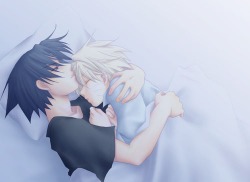What is Yaoi?

Yaoi is a publishing genre which originated in Japan and often encompasses manga, dojinshi, anime, and fan art. It is homosexual love between male characters and is sexually explicit. Some Westerners consider yaoi to be synonymous with Shounen-Ai, which contains similar themes; however by definition this is incorrect, and shōnen-ai material is not sexually explicit.
Terminology
Pronunciation:
Strictly speaking, all three vowels should be pronounced in separate morae, yielding a three-mora word, /jaoi/. However, yaoi is frequently heard as only two syllables, where under acceptable pronunciation produces the phoneme /oi/ with the 「お」 and 「い」 syllabic characters. In the United States, it is commonly mispronounced as /jaʊi/ or /jeɪɔɪ/, "YOW-we".
Usage:
Yaoi, outside of Japan, is an umbrella term for all male/male erotic comics made for women from Japan; as well as male/male erotic comics made in the west. The actual name of the genre in Japan is called 'BL' or 'Boy's Love'. BL is an extension of shoujo and Lady's categories, but is considered a separate category. Like 'Yaoi' is used in the United States, 'BL' is used in Japan to include: commercial and amateur works, works with no sex, works with sex, doujinshi about adolescents with little or no sex, works in all types of media - manga, anime, novels, games, and drama CDs with male/male content, and characters of all ages in male/male content. Terms such as yaoi, shounen-ai, tanbi, June, and original June, are all referred to in Japan, as 'BL'. However, it does not include gay publications.
Though yaoi is sometimes used to refer to any male homosexual content in film and print media, particularly in works created by females, that is generally considered a misuse of the term. Professional Japanese artists, such as Kodaka Kazuma, are careful to distinguish their works as "yaoi," rather than "gay," when describing them to English-speaking audiences.
Seme and Uke:
The two participants in a yaoi relationship are often referred to as seme ("attacker") and uke ("receiver"). Although these terms originated in martial arts, they have apparently been used in a sexual context for centuries and do not carry any degrading connotations. Seme derives from the Japanese verb semeru (“to attack”) and uke from the Japanese verb ukeru (“to receive”). Though gay males are often referred to in English as "tops" or "bottoms," seme and uke are more nearly analogous to "pitcher" and "catcher."
The seme is often depicted as the stereotypical male of anime and manga culture: restrained, physically powerful, and/or protective. The seme usually has a stronger chin, shorter hair, smaller eyes, and a more masculine demeanor than the uke. The seme usually pursues the uke.
The uke is usually more androgynous or effeminate appearance and demeanor and is often smaller and sometimes unrealistically girlish in behavior.
Though these stereotypes are common, not all works adhere to them. For example, some of the anthologies published by Be x Boy feature stories on themes such as "younger seme" or "reversibles." The "height rule," the implication that greater height confers greater power, is also sometimes broken.
